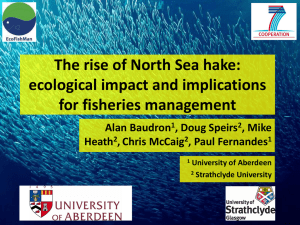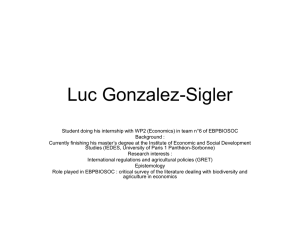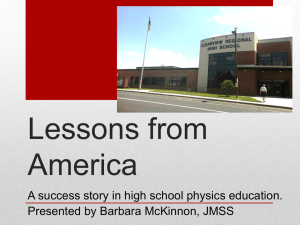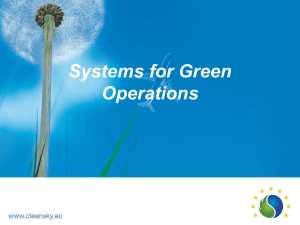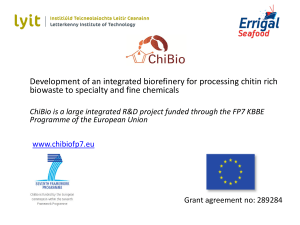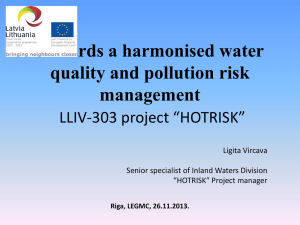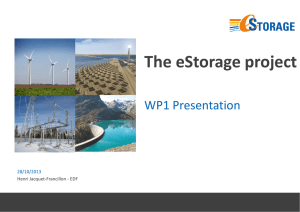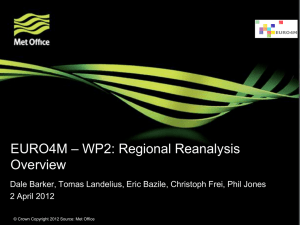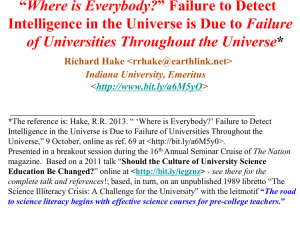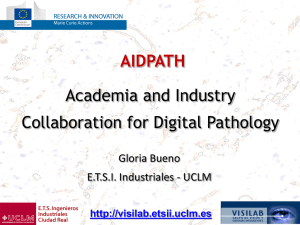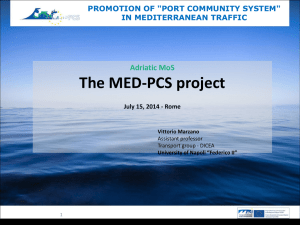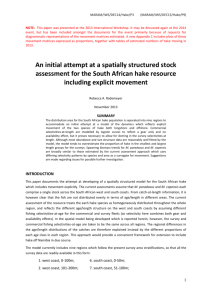PowerPoint-præsentation
advertisement
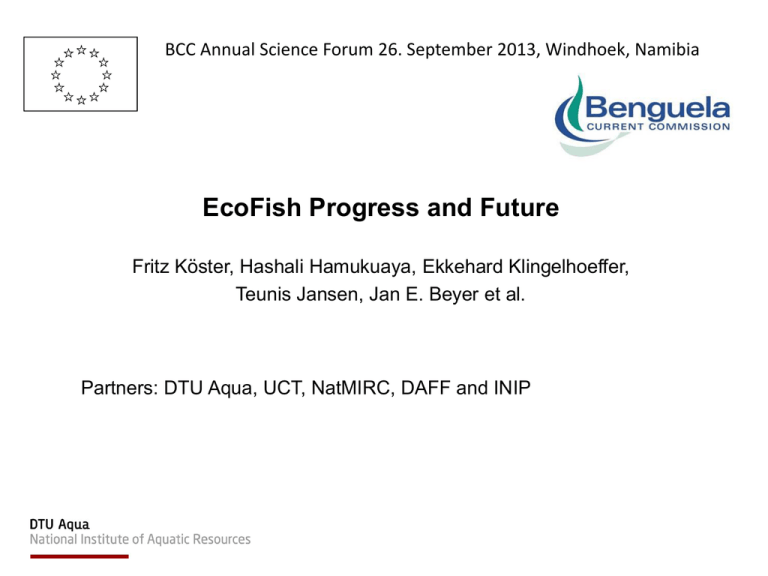
BCC Annual Science Forum 26. September 2013, Windhoek, Namibia EcoFish Progress and Future Fritz Köster, Hashali Hamukuaya, Ekkehard Klingelhoeffer, Teunis Jansen, Jan E. Beyer et al. Partners: DTU Aqua, UCT, NatMIRC, DAFF and INIP Objectives of EcoFish • Improve the understanding of spatial population dynamics of fish stocks in the Benguela region • Enhance the knowledge on stock structure, growth and mortality rates as well as catchability, information to be used in fish stock assessments • Establish improved statistical stock-assessment methodologies and establish trans-boundary assessment models that could provide a basis for regional fisheries management advice • Develop methods for including stakeholder knowledge in stock assessment and fisheries management • Training and capacity building in methodologies throughout project. Work Package linkages Experience based knowledge “Fishermen” WP3 Shareholder knowledge & acceptance WP2 Data based scientific knowledge Catchability WP3 Decision support tools Stock structure Growth WP2 Trophodynamics WP1 Model based scientific knowledge “fishermen” “scientists” Stock assessment I phase I Stock assessment II phase II WP4 Training Capacity building Work Package linkages Experience based knowledge “Fishermen” WP3 Shareholder knowledge & acceptance WP2 Data based scientific knowledge Catchability WP3 Decision support tools Paulus Kainge et. al. Kai Wieland & Deon Durholtz Marek Linpinski & Conrad Matthee Stock structure Growth WP2 Trophodynamics Beau Tjizoo & Deon Durholtz Johannes Itembu WP1 Model based scientific knowledge “fishermen” “scientists” Stock assessment I phase I Stock assessment II phase II WP4 Training Capacity building Work Package linkages Experience based knowledge “Fishermen” WP3 Shareholder knowledge & acceptance WP2 Data based scientific knowledge Catchability Stock structure Growth WP2 Trophodynamics “fishermen” “scientists” WP3 Decision support tools Paulus Kainge et. al. Kai Wieland & Deon Durholtz Marek Linpinski & Conrad Matthee Beau Tjizoo & Deon Durholtz Johannes Itembu WP1 Model based scientific knowledge John Kathena et al. Stock assessment I Stock assessment II phase I phase II Teunis Jansen WP4 Training Capacity building Work Package linkages Experience based knowledge “Fishermen” WP3 Shareholder knowledge & acceptance WP2 Data based scientific knowledge Catchability Stock structure Growth WP2 Trophodynamics “fishermen” “scientists” Barbara Paterson WP3 Decision support tools Paulus Kainge et. al. Kai Wieland & Deon Durholtz Marek Linpinski & Conrad Matthee Beau Tjizoo & Deon Durholtz Johannes Itembu WP1 Model based scientific knowledge John Kathena et al. Stock assessment I Stock assessment II phase I phase II Teunis Jansen WP4 Training Capacity building Workplan WP1 Task 1.1 – National hake stock assessment data and compilation procedures (Deliverable 1.1) 1. hake stock assessment workshop in 2011 and follow-up work – Set up of state space assessment model (SAM) for hake (Deliverable 1.2) Namibian hake Web interface for SAM – Comparing results from SAM to Statistical catch at age model (SCAA) (Deliverable 1.3, part I) Namibian hake and horse mackerel Recruitment of Namibian hake 45000 40000 SAM 35000 SCAA 30000 25000 20000 15000 John Kathena et al., this conference 10000 5000 Year 2010 2008 2006 2004 2002 2000 1998 1996 1994 1992 1990 1988 1986 1984 1982 1980 1978 1976 1974 1972 1970 0 1968 Numbers in Millions (0-yrs old) • Workplan WP1 • • • • Task 1.1 cont. – Data compilation for transboundary analyses, review of data, data compilation procedures, e.g. split of species Establish trans-boundary assessment data in progress. Methodology for splitting hake species established, split for Namibian hake done, for SA hake: review of splitting approach by DSWG as part of OMP revision process. Compiling surveys as assessment input continuously. Task 1.2 – Modify SCAA assessment model for SA hake to a spatial-box model with movement In progress, model coded and first indicative results available as part of the SA OMP revision process Task 1.3 – Compilation of stock assessment data for horse mackerel and sardinella, inclusive relevant quality measures (Deliverable 1.4) Namibian horse mackerel SAM assessment, but sardinella down-prioritised Contribution to Pelagic Stock Assessment WG, 5-7. November 2013 – SAM model for horse mackerel and sardinella (Deliverable 1.9) Horse mackerel (presented at ASF 2012), but not Sardinella Task 1.4 – Hake stock assessment with results from WP2.2 to be integrated WP 2 Input to stock assessment models 1. Determine hake stock structure through genetic analysis 2. Correct time series of hake catch per unit effort data according to environmentally-driven differences in catchability 3. Improve estimates of hake, horse mackerel and sardinella growth rates through improved ageing 4. Determine the trophic position of hake, horse mackerel and other demersal and pelagic fish in the northern Benguela WP 2 Input to stock assessment models WP2.1 delivered: Population structure, need to know the spatial lifecycle on a demographic time scale; fundamental for assessment, i.e. which stocks to assess? Spawning time and place (Jansen et al., this conference) Migration based on GeoPop (Jansen et al., this conference) Test of stocks hypotheses and attempt to estimate straying (Jansen and Berg) Genetics in progress (Lipinski & Matthee, this conference ) WP2.2 delivered: Gear selectivity, key to combined survey datasets Cotter report Output from GeoPop (Jansen et al., this conference) Catchability, will return to this WP2.3 delivered Growth / aging, essential for age structures models, will return to this Wilhelm (submitted) compared to GeoPop (Jansen, this conference) WP 2 Migration, population structure, growth and trawl selectivity examined with GeoPop (M. capensis, similar results also on M. paradoxus) • • • Demersal trawl surveys: Africana WC+SC, Nansen, Blue Sea, 1991-2012, 8,600 standardized demersal trawl hauls GeoStatistical population model (GeoPop) Estimates: – – – • Gear selectivity and efficiancy Growth Distribution by age Suggests – – – – – Migration through life 2-3 semi-isolated groups, that may experience different growth and mortality rates Not matching traditional stocks (transboundary!) Meaningful hydrographic borders Next: Test as distinct or connected stocks Wind speed WP 2.1 Stock structure Genetic analyses (Lipinski & Matthee, this conf.) M. paradoxus M. capensis Improved sampling : Four regions included: 2012 + 2013 M. paradoxus = 897 fish M. capensis = 974 fish The highest level of differentiation was detected among the Namibian and West – Coast SA samples for M. paradoxus. Weak signal, pairwise values were not significant between any of the four sampling sites! However, mtDNA and microsatellites samples from 3 years under analysis; conclusions need to await these results, available in 2014. 12 WP 2.2 Catchability SA west coast Exploratory analysis documents that: 1) Time of day effect is not relevant (random station allocation, fishing during daytime only) 2) Wind effect in a part of the area important (list of stations which should be discarded has been provided for 2002 and 2010 – 2012, other years to be checked in 2014) CPUE at stations fished twice at different wind conditions in the southern part of the survey area in 2003 10000 160000 M. capensis (all sizes) 8000 M. paradoxus 140000 • Catch rates considerable higher at moderate than at strong winds • Effect of strong SE wind / jet current in a part of the survey area (all sizes) CPUE (kg/nmi2) CPUE (kg/nmi2) 120000 6000 100000 strong wind moderate wind 4000 80000 60000 40000 2000 20000 0 0 150 200 250 300 350 400 450 500 Depth (m) Kai Wieland & Deon Durholtz, this conference 150 200 250 300 350 Depth (m) 400 450 500 WP 2.2 Catchability SA west coast 3) No indication that ‘green water’ effects seriously the quality of the survey indices but the process needs to be studied in 2013/2014 (commercial & scientific vessels) 4) High portion of M. paradoxus at depths larger than covered by the survey in 2002 – 2010 depending on bottom temperature, method for ‘adding’ biomass by length group requires validation (planned for 2013/2014) SA south coast No analysis done but 1) and 3) likely also true, 2) (and 4) ?) not relevant unlikely that correction of survey indices is necessary (except for change of trawl) Namibia 1) Exploratory analysis documents that time of day effect is probably relevant (station allocation along transect, fishing also at night, unbalanced design with considerable differences between years bias of survey indices) 2) Effect of hydrographic factors (O2, ‘green water’) indicated, but not yet analyzed 1) and 2) to be studied in 2014 – 2015 (Kainge et al., this conference) Cape hake WP 2.4 Age reading and growth Objective Validate age determination methods for hake, horse mackerel and sardinella to ensure accurate estimates of age (and hence growth) for input to regional stock assessment models being developed Approach (Tjizoo & Durholtz, this conference) Initial work plan developed for the ECOFISH proposal incorporated a suite of approaches, includeding radiochemical dating, mark-recapture experiments and marginal increment analyses. Most approaches have been discarded due to a combination of funding and capacity constraints. Analysis of otolith growth patterns monitored over time, as developed by Margit Wilhelm during her Ph.D., has been identified as potentially most useful approach. 15 WP 2.4 Trophodynamics Objective To determine the trophic position of hake using stable isotope technics. Results (Itembu, this conference) Both hake species showed significant size-specific shifts in δ15N MP displayed a stronger relationship between size and δ15N MP feed at higher trophic position than MC Isotope mixing model indicates relatively low predation on hake by hake Status and plans • Field sample collection is finished • Finalization of laboratory sample Analyses (October 2013 – March 2014) • Data analyses (April 2014-August 2014) • Comparison of ecosystem models results and stable isotope results (September 2014February 2015). Workplan WP1 (phase 2) • Task 1.4 cont. – Extend spatial SCAA box model for hake to include Namibia, taking into account stock-structure within species with input from WP2.1 (Deliverable 1.3, part II) Planed for 2015 • Task 1.5 – Modify SCAA to take account of hake cannibalism and inter-species predation with information from WP2.4 In progress for reporting at DSWG December 2013 • Task 1.6 – Extend SAM to cover two species, SA west and south coast and possibly also the Namibian regions with input from WP2.1 (Deliverables 1.6) Extend SAM to take account also improved growth and catchability estimates (input from WP2.2 & 2.3) Workplan WP1 (phase 2) • Task 1.7 – Spatial dynamics of hake considering survey gear catchability (GeoPop) (Deliverable 1.8) Migration, population structure, growth and trawl gear selectivity of hake examined with a geostatistical population model (Jansen et al., this conference) M. capensis WP 3 Incorporation of stakeholder knowledge Objectives 1. Develop social and economic indicators for fisheries 2. Develop expert systems to integrate multitude of indicators into a single assessment 3. Develop methods for including stakeholder knowledge in assessment and management Approach EAF conceptualisation: objectives hierarchies for the Namibian hake fishery Integration of fishers knowledge into stock assessment Spatial distribution of fishing effort Hake migration Stock structure Effort and efficiency Barbara Paterson, this conference with focus on the latter WP3 Conclusions 1. Understanding of fish & fishing behaviour important for accuracy of assessment Log-book data require interpretations Knowledge on stock structure, distribution and migration Knowledge on efficiency (e.g. technological creeping) 2. When stakeholder and scientific information match, uncertainty in assessment and management can be reduced 3. When information diverge, further investigations are needed to strengthen the knowledge base WP 4: Training and capacity building Plans for 2013-2014. • WP1 course held in 6-10. May 2013 in Swakopmund with scientists from Angola and Namibia, will be repeated 7-11. October, Cape Town • WP1 SAM introduction to stakeholders, 4. October 2013, Walvis Bay, more to follow… • WP1 follow-up course Fish stock assessment planned for October 2013 (with introduction to data handling/sharing and focus on SAM) delayed to 2014, coupled to R-course • WP2 course on Exploratory analysis of survey data linked to environmental information, 10-14. June 2013, Lobito • Series of WP1-2 Technical workshops have been hold, e.g. in genetic analyses at Stellenbosch University • WP3 Contributions to various EAF workshops organised by BCC • 2 Ph.d. enrolments (WP1 and WP2) at DTU, 3 further in preparation stage • Post-doc in stock assessment employed at BCC, Post-doc in ageing in preparation EcoFish mid way status (progress against objectives) • Improve the understanding of spatial population dynamics of fish stocks in the Benguela region Substantial progress made in compilation of catch data, analyses of survey results, both through analysis of catch rates and geostatistical modelling (GeoPop), but much more potential, e.g. inclusion of hydroacoustic surveys • Enhance the knowledge on stock structure, growth and mortality rates as well as catchability, information to be used in fish stock assessments Genetic analyses in progress, but require higher effort than expected; catchability analyses progresses – field part a bit delayed due to technical problems, but sea trials commenced in SA and in planning for Namibia; growth analyses/ageing a substantial challenge; trophodynamic analysis on its way, implementation in stock assessment focusses on cannibalism, how important is that? EcoFish mid way status (progress against objectives) • Establish improved statistical stock-assessment methodologies and establish transboundary assessment models that could provide a basis for regional fisheries management advice Different SAM models set-up (flexible, relatively easy to use, web-based model); comparisons to SCAA as standard assessment model conducted; SCAA being made spatially explicit for SA and will include cannibalism; but both models not transboundary yet; coupling of SAM and GeoPop an option for the late part of the project. • Develop methods for including stakeholder knowledge in stock assessment and fisheries management Results from industry survey for Namibian hake confirms largely WP2 findings on distribution, diurnal and horizontal migration, catchability, partly also stock structure, merger of information with WP2 also in publications. • Training and capacity building in methodologies throughout project. Series of workshops and courses conducted, but participation often local; repetition in different locations necessary; higher effort than expected – advantage that level can be adjusted to local needs. Conclusions Challenging project, of high importance to build up international and transboundary stock assessment and advisory capabilities in BCC. Progress is good, quoting Monitoring Report from 2. August 2013: “so far highly successful project” … but it needs to be recognised that we deal with some problems hardly solved in other regions of the world, even with well established international stock assessment/advisory organisations; these include: spatially explicit stock assessment models, catchability changes in relation to environmental changes, ageing/growth of hake. Way forward will be incremental and through international WG’s. BCC data handling Not part of the project, but projects assists BCC; suggestion to intensify cooperation with International Council for Exploration of the Sea (ICES) to assist in building up or take over central database functions. Planning second phase for EcoFish It is expected that all major scientific and technical project goals are reached; however even if the project will deliver data, information, models and work processes to enable international stock assessments by BCC, successful and sustainable implementation requires a follow-up project. Thank you for listening !
